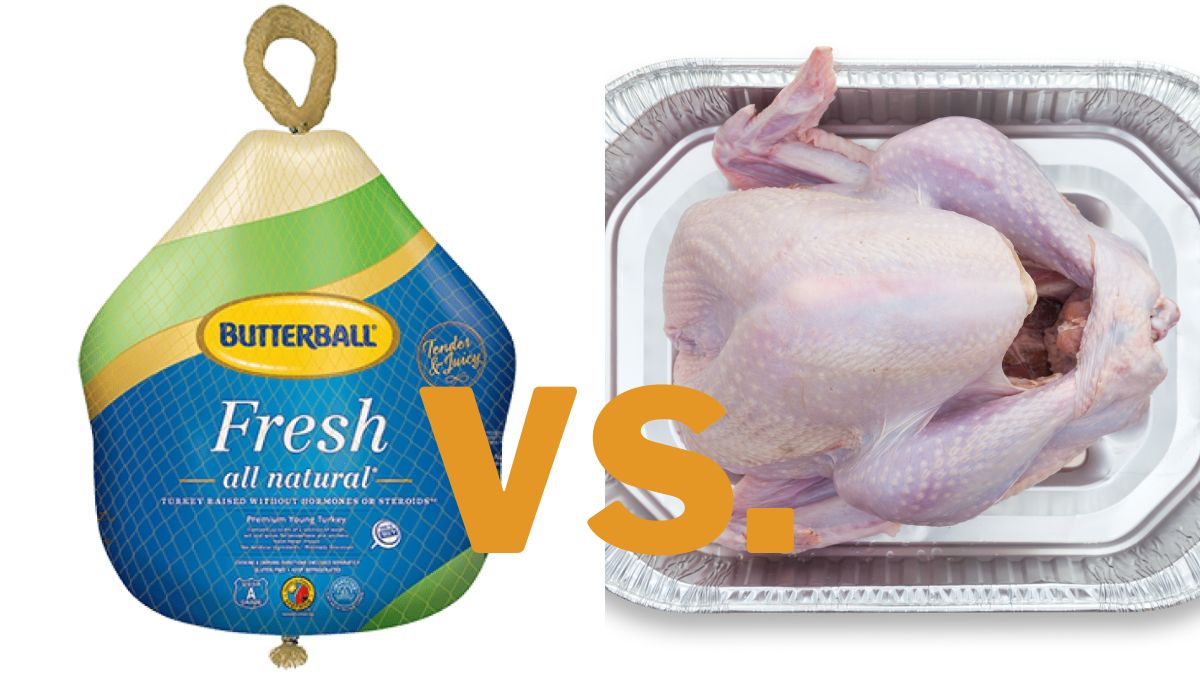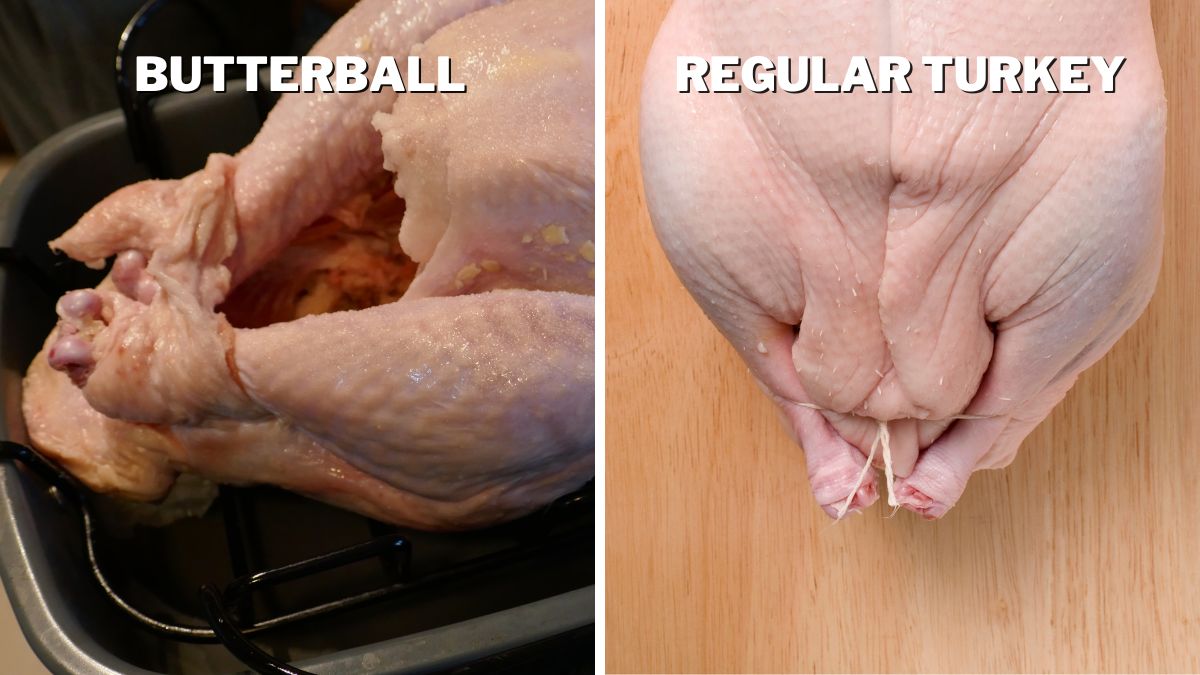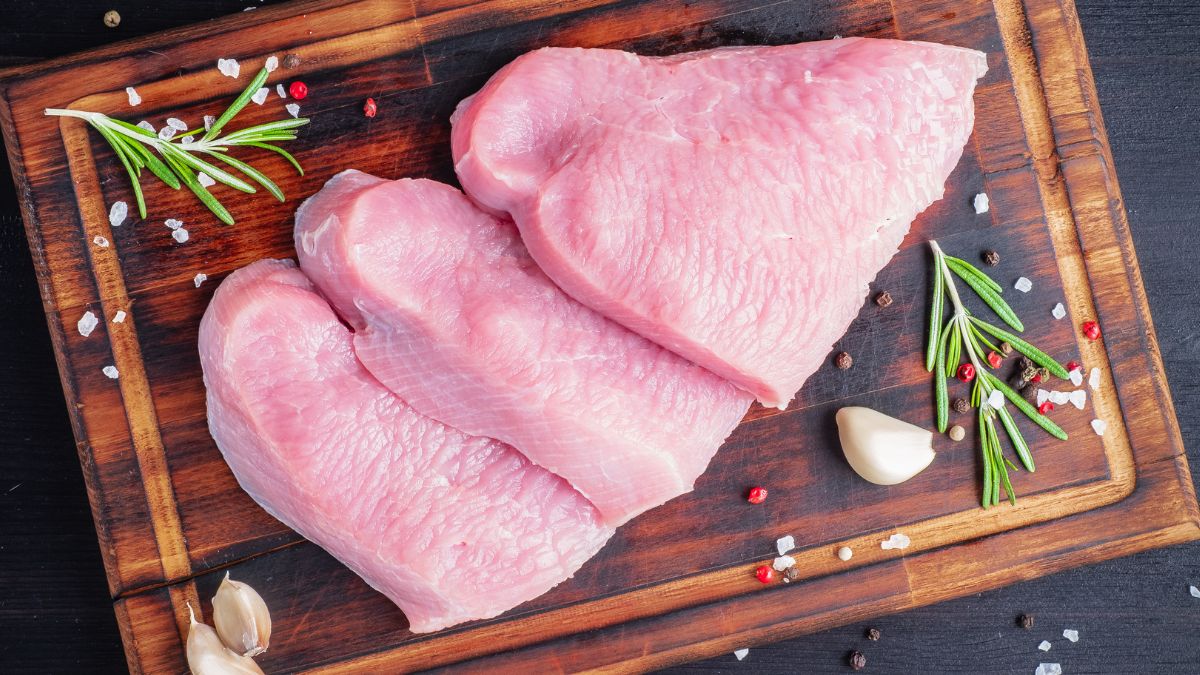Butterball Turkey vs. Regular Turkey: Differences & Which Is Better

I’m always taken aback when it’s time to choose the turkey for a big dinner, as there are so many brands and varieties on the market. This is a good thing, though, since so many choices make companies try better than their competition. Regular, conventional, or supermarket-label turkeys are very popular and often on sale and advertised with big signs. On the other side, Butterball turkey is a staple of American cuisine, and it doesn’t require a special announcement as everyone knows about it. So, what are the actual differences between Butterball and regular turkey, and which is better?
Butterball turkey is self-basted, which secures tender and juicy meat, unlike regular turkey, which you have to brine yourself. It is also, unsurprisingly, about double the price of regular, but its package is handier. More importantly, the Butterball Company treats its birds better, but some labels are misleading.
Animal welfare and marketing are topics close to my heart, so I love to research everything about them! There are definitely eye-catching labels that mean nothing in the end, but big words and the right perspectives sell at the end of the day! Read on to see what I’m talking about!
How Is Butterball Turkey Different from Store Brand Turkey?
Butterball is a company with a long-living tradition of quality, and there are definitely some differences that make them stand out. There probably aren’t as many as you would expect. I was surprised, as well!
Preparation
Butterball turkey comes pre-brined, unlike regular turkey, and that’s the main difference in preparation. Brining is the first step in making tender, juicy, and soft meat, whether you pick out the wet or dry method. That means the Butterball turkey is oven-ready as soon as unpacked, while the regular turkey is a bit more time-consuming.
If you skip brining, you’re definitely risking drying out, as it improves the moistness and flavor of the meat. Depending on how big your turkey is and which method you choose, the process lasts between 8 to 24 hours. Dry brining in salty rub lasts longer, so opt for wet brine in saltwater if you’re short on time.
Moreover, you can roast the meat similarly, but you don’t need to add any liquid to the bottom when baking Butterball. Just rub some oil over the skin to prevent drying out of the upper parts of the meat, plus the crust will be delish! Also, the instructions say not to cover the turkey till the last roasting phase and then only lightly.
On the other hand, I found steam baths or constant basting are the best ways to keep regular turkey succulent. You don’t need to do any of that for the Butterball, as the brine is injected deep into the meat.
Both varieties – Butterball and the regular turkey, are ready for stuffing. The main difference between them is in the way how legs are tied. Regular turkey comes fixed with the help of kitchen twine, while Butterball uses skin as a natural leg tuck.
This is super convenient as you don’t have to think about removing any plastic or metal ties and clips. It also makes serving the stuffed bird a breeze since it’s immediately ready for the table.

Taste
Regular turkey is like a blank canvas where you can adapt all the seasoning to your taste. I like to prepare herb butter and rub it all on the bird to absorb the flavor, along with fresh garlic.
When it comes to Butterball turkey, the meat is infused with brine, but it’s also a bit seasoned, so you can’t absolutely alter the flavor as you like it. You have to be careful with seasoning as it’s super easy to oversalt it, too. It’s a must to rinse out the meat, yet the saltiness will stay there along with spices, nonetheless.
I would recommend adding fresh or dry herbs and stuffing into Butterball turkey to subtly add up the aroma and keep the succulency. And here’s how you can cook it for the best result!
Meat Treatment
You may think tons of misleading labels are the best deal, but some requirements from USDA Food Safety and Inspection Service can’t be violated. I’ll write everything you have to know to help you choose the best quality meat for your family and friends. Here’s what to keep an eye on!
Antibiotics, additives, and hormones are all big words that everyone wants to escape. That’s why the lack of them is emphasized on the packaging — for example, antibiotic-free labeled turkey doesn’t mean that an animal never consumed them, but only the right kind of them. To simplify, there is a list of drugs that can be used, but only if the turkey is sick. [1]
Still, the withdrawal period needs to pass, so the turkey can be considered antibiotic-free. On the other side, there are growth and prevention antibiotics that producers give, along with drugs, to improve the quality of meat and feed efficiency. All of them are in low doses, though, so they can pass the legal limit. [2]
Butterball, as well, does the same. The company claims that there are no residual antibiotics in turkey’s digestive system when slaughtered, that’s why they have the label. Those drugs aren’t necessary, though, but are unfortunately rarely avoided, so that makes Butterball and regular turkey pretty much the same. [3]
Also, there are no legal hormones for turkeys at all, no matter if it’s noted on the packaging or not! Moreover, if you’re purchasing a fresh turkey – there are NO allowed additives, either. Processed meat can include some additives, even the minimally processed, like the Butterball brand. [4][5]
Claims like NO-HORMONES and ALL NATURAL are completely unnecessary, to be honest, just a marketing catch. Butterball turkeys are infused with saline solution with natural ingredients, only water, salt, and spices, so that makes them self-basted. Regular turkeys may contain artificial additives like MSG, but they will most definitely be on the ingredient list! [6][7]
Meat Quality

Turkey, in general, is very healthy meat to include in your diet – it’s lean and packed with proteins. But tenderness and taste depend on breed, growing process, and conditions. Of course, the meat will be tastier when birds eat natural food and roam freely in the fresh air.
Butterball turkeys have a cage-free label since their birds are free-roaming in barns, but that does not mean they are free-range. Conventional turkeys are probably raised in very limited and crowded spaces where they grow big at an unnatural speed. The difference here is in animal treatment only, not meat quality, as neither of them has access to outside. [8][9]
So, if you really want a bird raised as one – look for the free-range label. When speaking of food, regular turkeys eat processed feed only, as that’s the most convenient in mass farm conditions, while Butterball turkeys eat grains with animal protein to get the nutrients. None of these are the happiest solutions, as you can see, since the turkeys don’t eat fresh greens and bugs. [10][11]
Animal Welfare
The best thing about Butterball Turkey, besides the flavor, is the fact that the company is certified with an American Humane Certificate. This means they guarantee that birds have optimal conditions to grow and they aren’t mistreated. Furthermore, regular turkeys usually don’t have the certificate, and you can never know how bad or well they are treated. [12]
As I said before, those turkeys grow really fast, and the big birds you see in the freezer of supermarket chains are most likely packed with water to add up their weight. Because of that, they are heavier than it’s bearable, which leads to pain and leg fractures. This is definitely something to think about.
Packaging
The Butterball marketing department did a great job! Their package is super convenient and easy to remove – just pull it apart. Still, the best thing is inside – giblets are nicely stuffed into the cook-proof bag and left inside the turkey for easy removal.
Even if you forget it inside, nothing will happen! That’s top-tier for those who forget things like that, me included! ☺ Regular turkeys come in standard plastic sealed bags with additions in plastic bags, as well. The unpacking is a bit trickier, but not over-the-top.
If you’re curious about the behind the scenes process of farming and packaging, here’s a video of a farm’s turkey production process.
Prices
When comparing Butterball and conventional turkey prices, the first one is pretty costlier. For example, I found regular market turkey for $0.40 per lb on sale, but in the holiday season only, though. On the other side, I’ve never seen Butterball go lower than $0.99 per lb when on sale, off-season – double that price!
Which Is Better, Butterball or Regular Turkey?
It’s decision time! They both have pros and cons, of course, so let’s see! First things first, Butterball turkey is quickly ready, as it doesn’t require brining, but it’s already a bit flavored, so it’s not 100% customizable.
Butterball brand has some attention-worthy certificates, like the American Humane Certificate, but labels hormone-free and all-natural are surplus. Their turkeys have better living conditions, unlike conventional ones that are almost certainly mistreated. They eat more or less the same food and don’t spend time outside, so meat quality has no huge differences to start with.
When it comes to packing, expectedly, Butterball is the leader, but conventional turkeys are cheaper. I’ll definitely go for Butterball, mostly for animal treatment, nothing else. But I would always recommend turkeys from trustworthy local farms, if possible, to support small businesses and secure the best quality meat without any marketing tricks!
